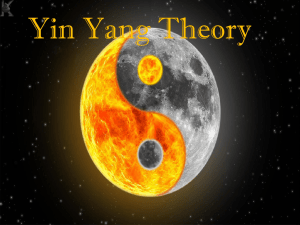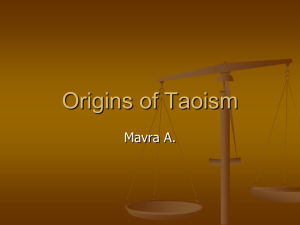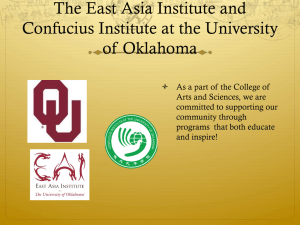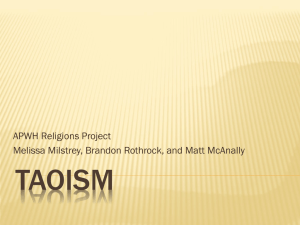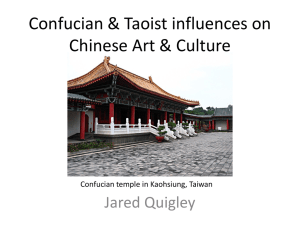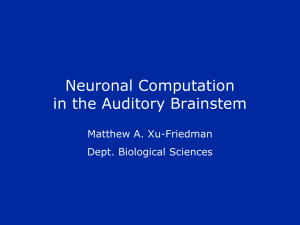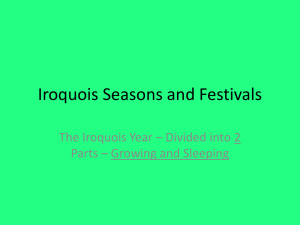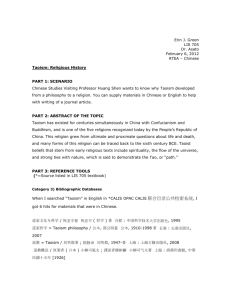Religious Taoism
advertisement
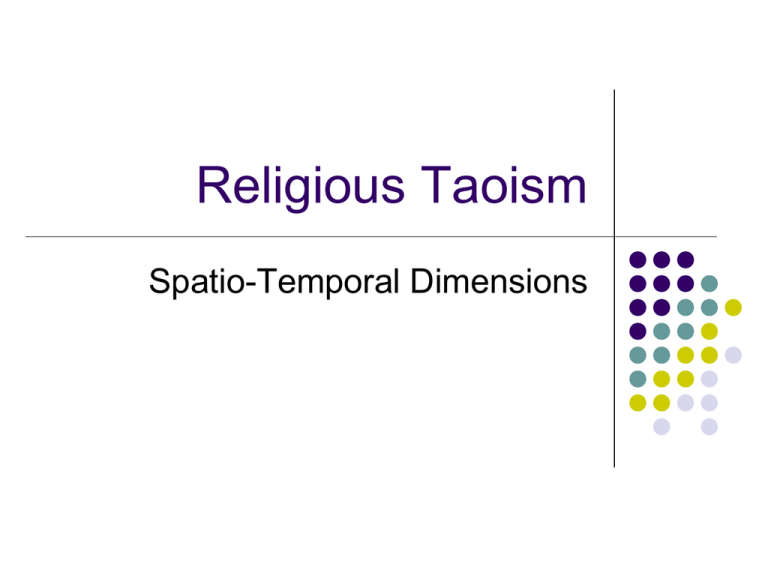
Religious Taoism Spatio-Temporal Dimensions Strands of Taoism (Smith typology) Non-formal “self-help” groups Philosophical Taoism (Lao-zi and Zhuang-zi) Hygienic/yogic Taoism (personal dimensions of yin-yang cosmology) Institutionalized “other-help” churches Religious Taoism (spatio-temporal dimensions of yin-yang cosmology) Strands of Taoism (Smith typology) Non-formal “self-help” groups Philosophical Taoism (Lao-zi and Zhuang-zi) Hygienic/yogic Taoism (personal dimensions of yin-yang cosmology) Institutionalized “other-help” churches Religious Taoism (spatio-temporal dimensions of yin-yang cosmology) Strands of Taoism (other names) Philosophical Taoism (eremitic Taoism) Hygienic/yogic Taoism (alchemical and monastic Taoism) Religious Taoism (priestly Taoism) spatio-temporal dimensions of yin-yang cosmology 1. Spatial Dimensions of Yin and Yang 2. Temporal Dimensions of Yin and Yang 1. Spatial Dimensions of Yin and Yang mountains and valleys / light and shadow the placement of cities, homes, graves Etymological background: yin and yang Wu-xing -- Five Phases 行 xing Five Phases / Processes / Changes / Elements YANG ORDER OF PRODUCTION wood > fire fire > earth earth > metal metal > water water > wood YIN ORDER OF OVERCOMING metal / wood wood / earth earth / water water / fire fire / metal Chinese vs. Greek “Elemental Theory” 五行 xing as “locomotion” wood fire earth metal water growing of wood burning of fire enveloping of earth hardening of metal moistening of water 彳 “Pictograph showing a person taking a small step” Orientation of human habitations: feng-shui (geomancy) “wind and water” “habitation”: living and dead 19th century Western characterizations of feng-shui “a mere chaos of childish absurdities and refined mysticism, cemented together, by sophistic reasonings, into a system, which is in reality a ridiculous caricature of science” “an abyss of insane vagaries” “a perverse application of physical and meteorological knowledge” “the biggest of all bugbears” Feng-shui and Ecological Consciousness Nature as a living, complementary force Natural beauty and form Links between topography and architecture An ideal of cosmic, social, and ecological harmony “a mere chaos of childish absurdities” East Wing, National Gallery, Washington, DC (I.M. Pei) “a ridiculous caricature of science” Hong Kong (New Territories) “an abyss of insane vagaries” “a perverse application of physical and meteorological knowledge” Beijing Blur Hotel designed by Pei Zhu Bank of China Tower (Hong Kong) “the biggest of all bugbears” “Bird’s Nest” Olympic Stadium (Beijing) Ai Wei-wei The entire building rotates by different degrees at different levels, corresponding with the surrounding scenery. Our aim is to provide 360 degree views, to awaken the city dweller's appreciation of nature, and to get them in touch with the sunlight and the wind. MAD is a Beijing-based architectural design studio dedicated to creating innovative projects. It combines a sophisticated design philosophy with advanced technology in exploring contemporary architecture, social, and cultural issue in today's China. We examine and develop our unique concept of futurism through current theoretical practices in architectural design, landscape design, and urban planning.In 2006, MAD was awarded the Architectural League Young Architects Forum Award. On-going projects include Absolute Towers in Toronto, 330-meter-high Sinosteel International Plaza in Tianjin, China, Phoenix Island master planning and architecture design, and large-scale public complex and residential housing in Denmark, Hong Kong, Dubai, Singapore, Malaysia, Japan and Costa Rica. MAD is seeking the most innovative architects and designers with different experiences to work on diverse projects worldwide. MAD office has an international workforce and welcomes applications from all over the world. 关于MAD事务所 MAD事务所是一家具有创新精神的建筑师事务所,我们关注当代的建筑、景观 设计及相关的城市、文化问题,并希望通过超前的理念为未来的城市提出独特、 有效的设计方案。 MAD目前在世界范围内有各种规模和类型的建筑项目,其中包括正在施工中的 多伦多梦露大厦(2006年MAD赢得该项目设计竞赛第一名),位于天津滨海新 区的358米超高层——中钢国际广场,三亚凤凰岛的整体规划设和建筑设计项 目,北海滨海居住社区,以及在丹麦,香港,迪拜,新加坡,马来西亚,日本, 哥斯达黎加等地的大型公共建筑和住宅项目。 MAD的设计作品得到世界范围的关注与报道。MAD获2006年度纽约建筑联盟 青年建筑师奖。MAD还举办了一系列个展。其中包括2006年MAD在意大利威 尼斯举办的“MAD in China”展览,与威尼斯双年展同步展出,在北京Tokyo Gallery举行了名为”MAD Under Construction”建筑设计展览。2007年MAD在 丹麦哥本哈根的丹麦建筑中心举办名为MAD in China”的漂浮城市系列个展。 2. Temporal Dimensions of Yin and Yang Festivals of the Calendar (all dates lunar) 1/1 5/5 7/15 11/15 Spring Festival: the Chinese “New Year” Double Yang Festival: Water/Cold Food Mid-Year Festival: Ghost Festival of Rebirth of Yang: Gods It lies behind the importance of the number seven in sacred writings and means that our sevenday week is a regular reminder of the ancient lunar calender. Days 1 to 14 Days 15 to 28 The Chinese Festival Year (excess of yang) 5/5 summer (season of gods) 7/15 (domination of yin) 1/1 (re-emergence of yang ) 11/15 (reemergence of yang) winter (season of ghosts) Festivals of the Calendar (all dates lunar) 1/1 Spring Festival: the Chinese “New Year” -- celebrating the re-emergence of yang 5/5 Double Yang Festival: Water/Cold Food -- overcoming the excess of yang 7/15 Mid-Year Festival: Ghosts -- observing the domination of yin 11/15 Festival of Rebirth of Yang: Gods -- encouraging the re-emergence of yang Spring Festival (1/1) Double Yang Festival (5/5) Ghost Festival (7/15) YUE LAN (HUNGRY GHOST) FESTIVAL Seventh Moon, Day 15 (August/September) For one long lunar month during the Hungry Ghost Festival, ghosts are said to roam the earth. Throughout this month Chinese people do their best to avoid late nights to steer clear of the spirits. In some areas of Hong Kong, visitors can see small roadside fires, where believers burn paper money and other offerings to appease the restless spirits. In Toucheng, the first Chinese settlement on the Lanyang Plain, the Ghost Festival culminates with the tradition of setting up towers and climbing them. Festival of Rebirth of Yang (11/15) Major Themes of the Taoist Classics 1. “Anti-Confucianism” 2. Zi-ran: Naturalness and Spontaneity 3. Wu-wei: Non-action 4. The Dao 5. Pu: The “Uncarved Block” 6. Uselessness 7. Hua: Transmutability 8. The Perfect One 7. Transmutability the Kun fish and the Peng bird 鯤 "Little Understanding and Great Understanding" (Ch. 1, Free and Easy Wandering) In the northern darkness there is a fish and his name is Kun (北冥有魚,其名為 鯤). The Kun is so huge I don't know how many thousand miles he measures. He changes and becomes a bird whose name is Peng (化而為鳥,其名為鵬). The back of the Peng measures I don't know how many thousand miles across and, when he rises up and flies off, his wings are like clouds all over the sky. When the sea begins to move, this bird sets off for the southern darkness, which is the Lake of Heaven (南冥者,天池也)... When the Peng journeys to the southern darkness, the waters are roiled for three thousand miles. He beats the whirlwind and rises ninety thousand miles, setting off on the sixth-month gale... … The cicada and the little dove laugh at this, saying, "When we make an effort and fly up, we can get as far as the elm or the sapanwood tree, but sometimes we don't make it and just fall down on the ground. Now how is anyone going to go ninety thousand miles to the south!“ If you go off to the green woods nearby, you can take along food for three meals and come back with your stomach as full as ever. If you are going a hundred miles, you must grind your grain the night before; and if you are going a thousand miles, you must start getting the provisions together three months in advance. What do these two creatures understand (之二蟲又何知)? Little understanding cannot come up to great understanding; the short-lived cannot come up to the long-lived (小知不及大知,小年不及大年). Dreams: Hua-consciousness painting by Lu Zhi (16th c.) Asian Art Museum San Francisco "The Butterfly Dream" (Ch. 2, Making Things Equal) Once Zhuang-zi dreamt he was a butterfly (昔者莊周夢為胡蝶), a butterfly flitting and fluttering around (栩栩然胡蝶也), happy with himself and doing as he pleased (自喻適志與). He didn‘t know he was Zhuang Zhou (不知周 也). Suddenly he woke up (俄然覺) and there he was, solid and unmistakable Zhuang Zhou (則蘧蘧然周也). But he didn’t know if he was Zhuang Zhou who had dreamed he was a butterfly, or a butterfly dreaming he was Zhuang Zhou (不知 周之夢為胡蝶與,胡蝶之夢為周與). Between Zhuang Zhou and a butterfly there must be some distinction (周與胡蝶,則必有 分矣)! This is called the Transformation of Things (此之謂物化). Spontaneity: Hua as model for living Responding to change Acting effortlessly Moving purposelessly Going where there is least resistance Responding to a shifting situation 8. The Perfect One Zhen-ren 真人 The Great Awakening (Zhuangzi, ch. 2) He who dreams of drinking wine may weep when morning comes; he who dreams of weeping may in the morning go off to hunt. While he is dreaming he does not know it is a dream, and in his dream he may even try to interpret the dream. Only after he wakes does he know it was a dream. And someday there will be a great awakening when we know that this is all a dream. Yet the stupid believe they are awake, busily and brightly assuming they understand things, calling this man ruler, that one herdsman -- how dense! Confucius and you are both dreaming! And when I say you are dreaming, I am dreaming, too, and words like these will be labeled the Supreme Swindle. Yet, after ten thousand generations, a great sage may appear who will know their meaning, and it will be as though he appeared with astonishing speed. 夢飲酒者,旦而哭泣;夢哭泣者,旦而田獵。方其夢也,不知其夢也。夢之 中又占其夢焉,覺而後知其夢也。且有大覺而後知此其大夢也,而愚者自以 為覺,竊竊然知之。君乎,牧乎,固哉!丘也,與女皆夢也;予謂女夢,亦 夢也。是其言也,其名為弔詭。 萬世之後,而一遇大聖知其解者,是旦暮遇之也。 The Taoist Sage “Godlike” qualities Unaffected by life and death Emotional equanimity “A mind like a mirror” “Sitting in forgetfulness” “The fasting of the mind” Contrasts between Confucianism and Taoism Confucian Taoist Heaven ceremony action society male adulthood moral perfection "build" "establish" being education hierarchy named North knowledge the ancients Nature, Tao simplicity non-action individual female infancy & old age spiritual tranquilty "nourish" "return" non-being self-transformation unity nameless South intuition pre-history Remnants of Taoism in Contemporary Chinese Culture Taoist responses to contemporary global issues violence arising from ethnic and political conflict urbanization and its attendant ills (from crime to unsightly cityscapes) ecological degradation and the worldwide decrease in forested or virgin land medical technologies which preserve life, but often at great material and spiritual cost greed and avariciousness, expressed both personally and nationally sexual ethics which are often distorted on the one hand by demeaning images and attitudes or, on the other hand, by religiously motivated prudishness lifestyles focused on personal achievement in highly artificial environments, with little opportunity for physical exercise, creative expression, or communion with nature (Nadeau, p. 110) Taoism as an Emerging World Religion Taoism as Anti-Judaism, Anti-Catholicism and AntiVictorianism (Nadeau, p. 122) Freedom Aestheticism and artistic expression Naturalism Holistic health and macrobiotic diet Non-competitive sport Ecological consciousness Sexual expression Spirituality and feminine images of the divine
